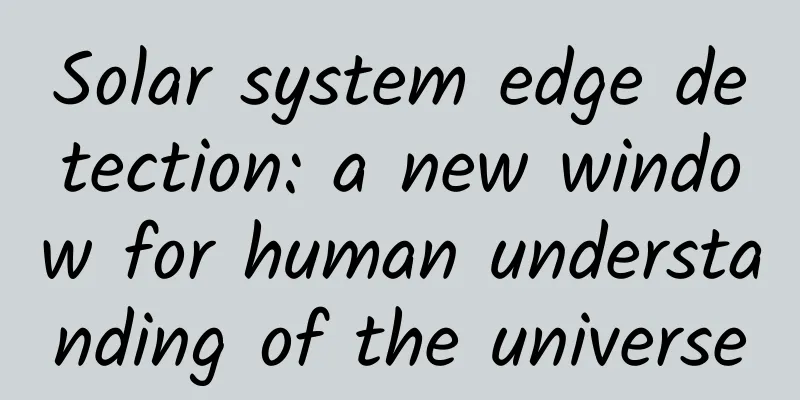Solar system edge detection: a new window for human understanding of the universe

|
The solar system is a huge celestial system composed of the Sun, eight major planets, nearly 500 satellites, more than 1.2 million asteroids, numerous dwarf planets, comets and interplanetary medium under the influence of the Sun's strong gravity. All celestial bodies revolve around the Sun. Solar system diagram As human beings' deep space exploration capabilities continue to improve, the means of understanding the universe are becoming more and more abundant and the scope is becoming wider. The exploration of the boundary of the solar system has become an important direction of human space activities and a new window for human beings to understand the universe. Where is the boundary of the solar system? What kind of new world is beyond the boundary? What difficulties need to be overcome to reach the boundary of the solar system? Where is the boundary of the solar system? In 1977, the United States launched Voyager 1 and 2 probes, and after completing the scheduled planetary exploration mission, they began to set off for the edge of the solar system. In August 2012, Voyager 1 flew out of the heliosphere at a distance of about 121 AU from the sun (1 AU is the average distance between the sun and the earth, 1.5×108 kilometers) and about 19 billion kilometers from the earth, becoming the first probe to enter interstellar space. Subsequently, Voyager 2 surpassed the heliopause in December 2018 and entered interstellar space. The heliopause and interstellar space are both concepts related to the boundary of the solar system. What do they mean? How far is the boundary of the solar system from us? Scientists have proposed three definitions of the solar system boundary. The first is based on the orbit of the planets, extending from the sun to Neptune, with a diameter of about 30 AU, which is the smallest boundary. This boundary is not fixed. In 2006, the International Astronomical Union kicked Pluto out of the planet team, which reduced the scope of the solar system by about one third. In 2016, scientists discovered that the orbits of six celestial bodies in the Kuiper Belt were abnormal, and speculated that there might be a ninth planet there. If this planet is actually observed in the future, the boundary of the solar system will be greatly expanded. The second definition is based on the top of the heliosphere, which is also where the two "travelers" once arrived. According to human observations of the sun and space, the sun continuously ejects supersonic charged particle streams, forming a solar wind that sweeps across space. On the other hand, the vast universe is filled with low-temperature interstellar media such as atoms, molecules, and dust. The solar wind gradually slows down while blowing away the interstellar medium, and eventually reaches equilibrium. The whole process is like the sun blowing out a "big bubble" of magnetized plasma in the Milky Way, and this big bubble is the heliosphere. Affected by the periodic changes in the intensity of solar activity, the intensity of the solar wind is constantly changing, so the shape and range of the heliosphere are not fixed. The boundary of the solar system defined by the heliosphere is about 80 to 150 AU from the sun. It took Voyager 1 and 2 nearly 40 years to reach here. The third definition is based on the gravitational range of the sun. Outside the heliosphere, there is still a wide range of celestial bodies orbiting the sun. This boundary is about 50,000 to 100,000 AU from the sun. The farthest is the Oort Cloud, a "large warehouse" filled with comets. The gravitational boundary is the largest boundary of the solar system, 1 light year away from the sun. The solar system is so vast, and between the solar system and other star systems, there is an even vaster interstellar space filled with sparse neutral particles, plasma, cosmic dust and other interstellar matter. In March 2013, the density of plasma detected by Voyager 1 in the nearby space increased by more than 40 times, and scientists concluded that it had flown out of the heliosphere and entered interstellar space. Challenge the unknown of mankind and explore the boundless boundaries So far, humans have launched thousands of spacecraft into space, most of which are in Earth orbit, more than 100 have flown out of the Earth-Moon system to explore the Sun, other planets and small celestial bodies, and a few have embarked on a longer journey to the edge of the solar system. They are Pioneer 10, 11, Voyager 1, 2 and New Horizons. Pioneer 10 and 11 were launched in 1972 and 1973 respectively. Pioneer 10 successfully crossed the asteroid belt between Mars and Jupiter for the first time, flew past Jupiter, and used Jupiter's gravity to accelerate it to fly out of Neptune's orbit in 1983. Due to energy limitations, when it lost communication with the Earth in 2003, it had already flown to a position of 80 AU from the sun and continued to move away from the center of the Milky Way. Pioneer 11 passed by Jupiter in 1974, used Jupiter's gravity to fly to Saturn, then crossed Saturn's rings and Neptune's orbit, and headed towards the center of the Milky Way. It lost communication with the Earth in 1995, and was 43AU away from the Sun. With the exploration of the Pioneers, the Voyagers' journey was smoother. Voyager 1 visited Jupiter and Saturn successively, and conducted detailed exploration of Saturn's rings and Titan's atmosphere. It is equipped with three nuclear batteries, which can support communication with the Earth until 2025, and its journey in interstellar space will continue for 40,000 years before it can enter the next star "bubble". Voyager 2 has another legendary experience. It was lucky enough to catch the "four-star tour" window that occurs once every 176 years, and achieved flyby detection of Jupiter, Saturn, Uranus and Neptune at the same time. The New Horizons probe was launched in the new century, entered orbit in 2006, and flew past Pluto in 2015. It flies at a high speed of 3.4 AU per year and is expected to fly to the edge of the heliosphere in 2030, which will take only 24 years, making it the fastest probe in human history. The boundary of the solar system is extremely far away, extremely cold, extremely dark, full of mystery and unknown, and is the limit of current human technological capabilities. The boundary of the solar system also contains important secrets and treasures. It is the first "line of defense" to protect the solar system from potential harm from galactic cosmic rays, and preserves information from the early days of the solar system. What is the propagation and evolution mechanism of the solar wind in the heliosphere? What clues do interplanetary dust clouds retain about the birth of life and the beginning of the solar system? Exploration of the boundaries of the solar system will open a new window for human beings to understand the universe, and the answers will gradually be revealed in the future. What technologies are needed to explore the boundaries of the solar system? The exploration of the boundaries of the solar system places higher demands on aerospace technology. It requires improving the basic technologies of materials, instruments, electronic components, etc. in extreme environments, and making breakthroughs in cutting-edge space technologies such as orbital design, new high-efficiency energy and propulsion technologies, ultra-long-distance measurement and control communications, and new scientific payloads. Exploring the boundary of the solar system is a long and time-consuming task, so on the one hand, the energy system of the probe needs to be able to maintain long-term stable operation. On the other hand, the farther away from the sun, the less solar energy the probe can obtain, so it is necessary to solve the problem of power supply under extremely dark conditions. At present, nuclear batteries are an important way to solve energy problems. Nuclear batteries generate electricity independently, have high energy density and long service life. Radioisotope thermoelectric generators (RTGs) are now relatively mature, using plutonium-238 as raw material. The half-life of nuclear batteries is as long as 88 years. The power supply life of Voyager 1 and 2 is more than 40 years. An important direction for nuclear batteries is to develop space nuclear reactor power supplies, which are more powerful and cheaper than isotope power supplies. When the technology matures in the future, it will improve the overall performance of the detector. The probe flies billions of kilometers and still maintains a continuous connection with the ground. It relies on the deep space tracking and control communication system, which can effectively control the flight of the probe and continuously transmit precious scientific data back to the earth. The farther the probe is from the earth, the weaker the communication signal and the longer the delay. It is necessary to design more efficient channel coding technology, break through the capture and tracking of extremely weak signals at ultra-long distances, and develop large-caliber ground antenna arrays and high-power transmitters to enable the earth's tracking and control capabilities to cover the solar system and effectively support the mission. Long-term flight exploration also places higher demands on the life of the probe. The life of an Earth orbit satellite is usually 10 to 15 years. Deep space probes have to fly and work in the harsh space environment for decades, which poses more severe challenges to the materials, components, system autonomous management and fault diagnosis and processing technology used. These problems need to be solved step by step. There are many unknowns at the boundaries of the solar system, which requires detectors with multiple functions and strong performance, equipped with advanced and rich scientific payloads, and conducting multi-type and multi-factor detection. Scientific payloads must not only continuously improve in terms of detection accuracy and range, high sensitivity, and lightness and miniaturization, but also minimize power consumption and compress data to ensure that the detectors can maximize their value. The exploration of the solar system boundary involves a large number of technical challenges in multiple cutting-edge fields, which will drive human space technology capabilities to a new level and achieve a new improvement in scientific and technological levels and innovation capabilities. (Author: Yang Shirui) |
<<: Panzhihua City, why doesn’t it look like a city in Sichuan?
>>: World Mental Health Day丨Ding Dong! Please keep this guide to mental health care!
Recommend
Zhang Xiaoyu of Changan Automobile: The new energy vehicle market has entered an era of multiple power sources
The demand for automobiles is becoming more diver...
Nanjing Tea Studio is recommended, and friends who have been there are full of praise
Recommendations for places to taste tea in Jiangn...
The Douyin advertising platform was launched for the third time. This time, the commission was reduced from 60% to 30%!
After being delayed for more than a month, Douyin...
A creative solution for high conversion advertising!
When doing information flow promotion, the page c...
Volkswagen Group's profit fell by nearly 40% in 2020, and its sales fell back to ten years ago
2020 was a difficult year for Volkswagen Group. G...
Let’s go, “group” to find the shale “underground palace”
In ancient times, people conducted hydrogeologica...
The world's most expensive iron sheet cools down: Shanghai license plate auction prices drop by up to 40%
Li Ming, who originally planned to buy a car in Ja...
National Ecological Day丨For the sake of environmental protection, is it wrong to turn on the air conditioner? Scientific and reasonable use is the key
There is a saying circulating on the Internet tha...
Can alarm clocks also threaten our health? Multiple alarm clocks make people fall into a "sleep swamp"
China Science and Technology News Network, Februa...
Why is the night sky so dark when there are countless stars shining in the universe? Solving the Olbers paradox
On a clear night, we look up at the sky and see a...
Operations = miscellaneous tasks? 90% of operators are going astray!
A few days ago, a colleague from my previous team...
Rules and strategies for being popular on Tik Tok!
Each traffic platform, including Taobao, WeChat, ...
Brand "Influencer Promotion" Strategy
Combining the cases of Coca-Cola and Perfect Diar...









